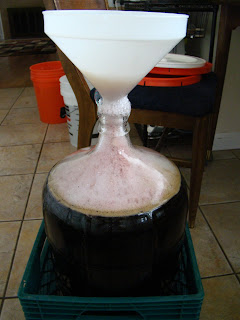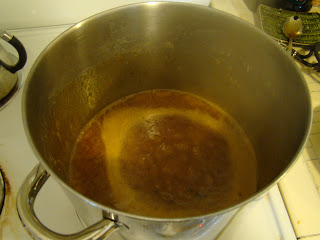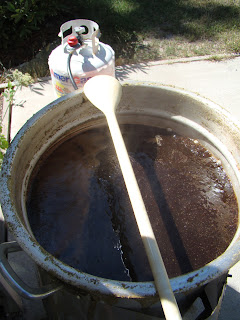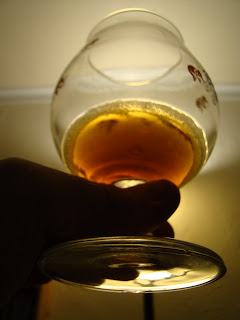For my last Chicago brewday, I was looking to make a beer that would refresh us as we unpack in our new place in Salt Lake City. Given how well last summer’s saison went over, another one, lower in gravity, was in order. Rye has found a solid place in my brewery over the last year, adding its spiciness and slick mouthfeel, so I wanted to make it a major player in this recipe.
I was also intrigued by how the Cherry Sour turned out following a long sour worting; it produced a prominent, very clean lactic sourness. While using a neutral ale yeast made for a fairly one-dimensional end product, it seemed this method, applied gently, could add another layer of complexity to what the saison yeast would contribute. I had just a couple ounces of Amarillo hops left to help build on the citrus character of the sour worting; to augment this I made my first foray into the world of New Zealand hops by adding an ounce of Pacific Jade, known for their citrus and black pepper notes (which should go well with the yeast).
When I started using rye, I followed conventional wisdom in keeping the percentage low to limit its purported gumminess from stopping up the mash. After reading about a beer made with 100% malted rye, I went bigger; I did an English bitter made almost entirely of rye, and from then on I haven’t had any of the mashing/sparging problems attributed to rye (or wheat, for that matter). Or at least I hadn’t until this brewday.
I mashed low to keep the final beer dry, as I did with the previous saison; despite the high percentage of rye in the mash and being in the temp range that can make its proteins so notoriously gummy, my experience with my system gave me confidence that I’d come sailing through this without incident. On top of that, my poorly insulated mashtun lost almost 15 degrees (F) during the long mash. The time came to start the vorlauf; I attached the hose, opened up the valve per usual, and after the first small surge, it slowed to a trickle. Minutes
went by, and next to nothing came out. I stirred the mash, I blew back through the tube, but nothing got it moving. So I resorted to a method I consider fairly un-French; I decocted.
This traditional German technique is used to raise the mash temperature by drawing off a thick portion of the mash (lots of grain, a little wort), boiling it, then adding it back to the main mash; it also tends to increase mash efficiency and produce maltier beers. I’ve only decocted once, to add extra maltiness to a small batch of weizenbock; in this case, though, I figured raising the mash temperature to “unglue” the rye proteins was my best bet and this was the only option I had for doing that on my setup. Unfortunately, the first decoction of just a couple quarts of thick mash didn’t have much effect at all, not even getting it back up to mash temp. So I doubled the size for the second decoction, which bumped up the temp to 160F. And the runoff was still interminably slow.
Eventually, I just brought the water for the first sparge to a boil and put it in on top of the mash, bringing the temp to 176F. That’s hot enough to start extracting unwanted tannins from the grains, but I hoped it would also be hot enough unstick the damn rye. And the runoff was STILL slow...but moving. The brewday ended up much longer than planned, but I was able to collect my runnings and get the thing to the boil. Between the Munich malt and the decoctions, this will probably fall on the maltier side of things than saisons normally do.

Of course, since I was sour worting this beer, I wasn’t even close to the end. After a 20-minute boil to get past the hot break and sterilize the wort, I cooled it down to about 115F, pitched my lacto starter, covered it with plastic wrap, and put it in the swamp cooler to let the bugs stew just overnight. The next day I found that I must’ve done a pretty poor job keeping the plastic wrap right down on the wort (to inhibit unwanted bugs that need oxygen, like acetobacter), as the wort had a frizzy, frothy head unlike the thick, controlled scum that showed up on the Cherry Sour. Still, it didn’t smell out of bounds, so to speak, and it was about to get a full 60-minute boil, so I didn’t worry too much about it.
The normal boil proceeded without incident, other than it seemed impossible to keep this one from boiling over; even though I’d boiled it past the hot break before souring, the head as it came to boil was immense, it still billowed up despite spritzing with a water bottle and keeping the flame low, and it persisted to some degree through the end of the boil. I chilled and set it aside, but was unable to get back to it for almost a full day. Eager to avoid a double souring, I brought it back to a short boil and chilled it again; on reheating, it had
a really wonderful, gentle fruit aroma that I attribute to the late hops.
Primary fermentation chugged away, and the dry hops went in right on top when it subsided. I’d only planned to have them in there for about 5 days, but with us busy packing, painting and cleaning for the imminent move, I didn’t have a chance to bottle before leaving for my music festival. By the time we get back, they will have had 3 ½ weeks of contact time. After all the hassle of this brew session, I’m looking forward to bottling this one, along with the Russian imperial stout, which has been sitting on oak for 2 months now.
Sour Rye Saison - Farmhouse ale with lacto starter
Batch size: 5.5 gallons
Projected OG: 1.048
Projected SRM: 8.4
Projected IBU: 28.9
Boil time: 60 minutes
Brewhouse efficiency: 80%
Grains
50% - 5 lb Rye malt
50% - 5 lb Munich
 Hops
Hops
1 oz Amarillo (7.8%) (20 min)
.5 oz Amarillo (10 min)
.5 oz Pacific Jade (13.4%) (10 min)
.5 oz Amarillo (Dry hop 5 days)
.5 oz Pacific Jade (Dry hop 5 days)
Yeast
Sour starter (pre-boil)
WY3711 French Saison - 3L starter from stirplate (primary)
Extras
1 tsp Irish moss (10 min)
1 tsp Yeast nutrient (10 min)
Water additions (mash)
2 g Chalk
Brewday: 2 July 2011
Mash-in: 12.5 qts @ 148F for 2 hours - added .5 qt to bring down temp
Temp drop to 134F; viscous & very slow runoff
1st decoction - 2 qts thick mash boiled for 5 minutes; raised temp to 144F
2nd decoction - 4 qts thick mash boiled for 5 minutes; raised temp to 160F
Sparge still stuck; eventually just added 1st sparge in with mash
1st sparge: 10 qts @ 212F - raised temp to 176F
STILL running off super slow!
Pre-boil volume: 7 gallons
Pre-sour OG: 10.8 P (1.044)
Boiled through hot break, cooled to 115F, pitched sour starter, covered in plastic wrap, kept warm in swamp cooler overnight
3 July 2011: Following 20 hours souring, normal 60-minute boil
4 July 2011: Didn’t pitch yeast yesterday; brought back to boil, cooled again, aerated, pitched - wonderful fruity aromatics on reheating
Fermentation started in basement at ambient (68F) for 2 days, then brought upstairs to ramp up
Dry hop: 11 July 2011
Bottled: 6 August 2011
FG: 1.010
ABV: 5%
Sample nicely tangy, but dominates the yeast; next time only sour a portion of the wort
Bottled with 5.5 oz table sugar
First tasting: 20 August 2011
Bright and fruity from the souring, but not overly so. Good breadiness as it warms, but sourness overshadows the yeast character.






















































